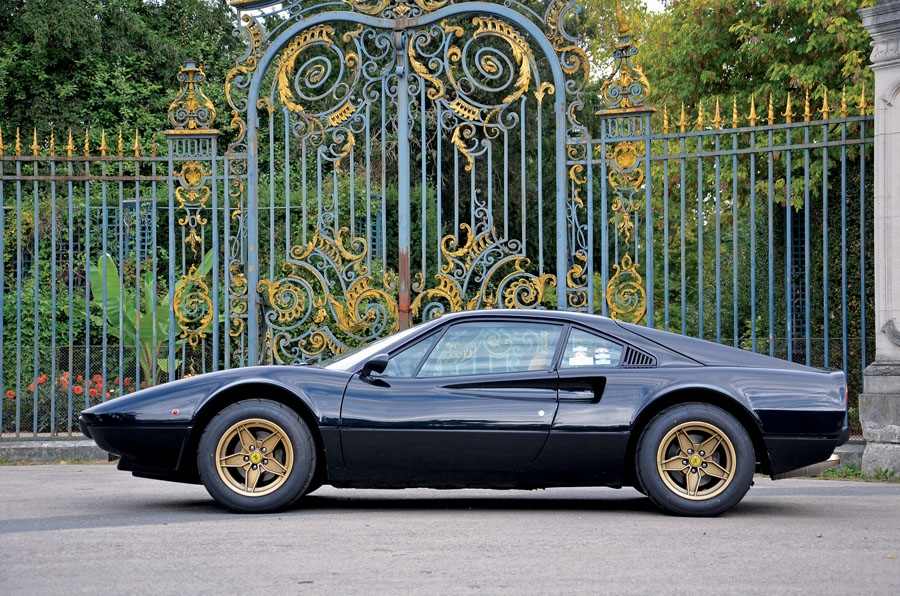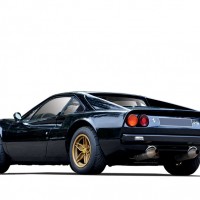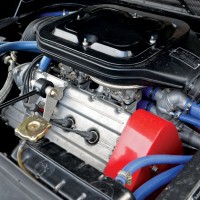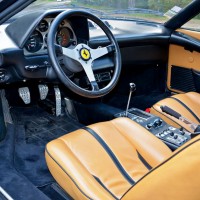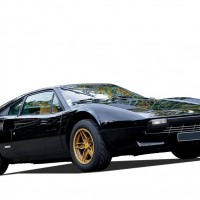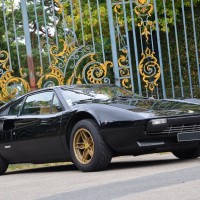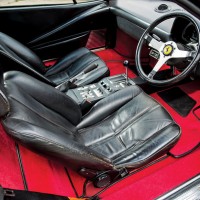1977 Ferrari 308 GTB Vetroresina
Chassis number 20271; engine number 00441 This superb fiberglass Ferrari 308 has always been fastidiously maintained. During its restoration it showed no signs of previous repair. The engine was refurbished in 2000. The car has therefore been completely overhauled and fitted with a high-performance exhaust. The current owner sent the car to Ferrari after purchasing, where they found no significant faults. The original rims with four new Michelin XWX tires were installed after our photos were taken. The rims seen in our photos will be supplied with the car. The “polyester” or “glass-reinforced plastic (GRP)” 308 GTB is the lightest and purest of all the 308s, making it a highly sought-after collector car today. This car, Lot 228, sold for $164,215, including buyer’s premium, at Artcurial’s Paris auction on September 12, 2014.1977 Ferrari 308 GTB Vetroresina
Chassis number 20543; engine number 20543 When Ferrari introduced the 308 to the public in 1975 at the Paris Salon, it was the first time that they had chosen to use fiberglass for the bodywork. The Vetroresina, as it is known, was manufactured from 1975 to ’77 before the introduction of the steel-bodied cars in mid-’77. Only 154 right-hand-drive Vetroresinas left the Maranello factory, making it the rarest model 308 money can buy. This car spent many years in the collection of Harrods’ owner, Mohamed Al-Fayed, before he donated it to a charity auction. The car has been well maintained, as indicated by a history book that accompanies the car, noting over £28,000 in repairs. Engine, gearbox and cosmetics have all been freshened. The car comes complete with the original books in the Ferrari leather wallet. The odometer reads just 25,953 miles. This Vetroresina 308 comes with a solid history file and ticks all the right boxes in terms of mileage and ownership history. This car, Lot 349, sold for $202,531, including buyer’s premium, at Silverstone’s Birmingham, U.K., auction, November 16, 2014.SCM Analysis
Detailing
| Vehicle: | 1977 Ferrari 308 GTB Vetroresinas |
| Years Produced: | 1976–77 (fiberglass 308 cars) |
| Number Produced: | 712 |
| Original List Price: | $26,500 |
| SCM Valuation: | $100,000–$200,000; add $5,000 for dry sump |
| Tune Up Cost: | $4,000 |
| Distributor Caps: | $400 |
| Chassis Number Location: | Stamped into the upper frame on the passenger’s side next to the engine |
| Engine Number Location: | Center of V on passenger’s side |
| Club Info: | Ferrari Club of America |
| Website: | http://www.FerrariClubofAmerica.org |
| Alternatives: | 1982–88 Lamborghini Jalpa, 1973 Porsche Carrera RS, 1999–2004 Ferrari 360 Challenge Stradale,1975–89 DeTomaso Pantera GTS, 1972–76 Maserati Merak SS |
| Investment Grade: | C |
Ferrari 308s are pretty vanilla when it comes to exotic cars. “Magnum P.I.” gave them such exposure that despite being much rarer than a Porsche 911, they seem almost as common. They were built well and are not particularly prone to self-destruction.
While a full major service is expensive, interim cam-belt-only changes can drastically reduce service cost. Ferrari 308s are basically analog devices with no need for fancy computers for maintenance. Most good foreign car mechanics can keep one up.
Until recently, you could buy a decent 308 for under $30,000, with best-in-the-world examples barely breaking $50,000. Considering they are drop-dead gorgeous, a blast to drive, and say “Ferrari” on the nose, they have been the best buy of the sports car world.
Well the world has woken up and has started paying attention to 308s. Clean $30,000 308 GTBs can now break $50,000. $35,000 Quattrovalvoles have gone the way of dinosaurs. It’s a new world for 308s and 328s.
The rarest 308s
There were only 712 fiberglass 308s produced, and they are King of the Hill when it comes to 308 values. European 308 GTBs have a higher-horsepower, dry-sump engine. The dry-sump fiberglass 308s are the top dogs of all. The Artcurial and Silverstone 308s are both dry-sump versions, and they represent the pinnacle of the 308 market.
However, they vary in several areas — which resulted in quite different sale prices.
Silverstone’s car — chassis 20543 — was a much better car and was rewarded with a $38,000 premium. Resale Red is a reality, and with all other things being equal, Silverstone’s red car starts with a value edge. Silverstone’s car also was enhanced by celebrity ownership, documented history and an owner’s pouch.
Artcurial’s car — chassis 20271 — was saddled with aftermarket boy-racer mods, including silly-looking bomb mufflers, drilled pedals, a big radiator and gaudy engine detailing. Artcurial’s 308 also featured new leather that was not quite correct, and shabby, incorrect carpet.
Obviously, RHD cars do better in RHD markets, but it’s hard to put a value on LHD versus RHD versions. In this case, I think it was a wash.
The floodgates have opened
My charge on this assignment was to compare the sales of two cars, but the real story here is historical comparison.
A little over two years ago (September 2012, p. 58), I wrote a Ferrari Profile on another fiberglass 308 GTB. That car also sold at a European auction. The car was a U.S.-market, non-dry-sump model that sold for $70,000. I wrote that when a 308 sells for over $100,000, the floodgates will open.
A search of the SCM Platinum Auction Database shows the first recorded $100,000 sale was early this year. Barrett-Jackson raked in $114,400 for a yellow 1976 fiberglass example. While the sale got some tongues wagging, just a few months later a $155,000 sale was made, and then a backup $153,000 sale confirmed the 308’s ascension.
The $202,000 sale of Silverstone’s 308 was certainly impressive, but it is just a step on an upward spiral. When I wrote my 2012 column, I referenced the fiberglass 308’s value to a Porsche 911 RS and a Ferrari 246 Dino. The Dino and the RS have both seen unprecedented appreciation, while the 308 has lagged behind.
The jump in fiberglass 308 values is already trickling down to the more pedestrian 308 models.
I learned an important lesson a couple of years back when a Toyota 2000GT sold for a million dollars. Stunned pundits raved that the buyer could have bought a Ferrari Lusso, a Shelby Cobra — or any number of great cars for the same or less money.
The reporter’s comment went something like this: If a person can afford a million-dollar Toyota, they probably already have a Lusso or Cobra or anything else that they want. I’d never considered that perspective, and it changed my outlook on collector car values.
The bargain days are gone
It’s interesting how price can influence value. The same steak seems to taste better at an expensive restaurant than at a diner down the road. A shirt that appears garish at Macy’s becomes cool at an exclusive designer store. A $40,000 308 may never hit a wealthy collector’s radar, but at $150,000, he or she has to have it. That’s where we are today.
308s have always been great cars, but their entry pricing has kept them from being cool. It’s not logical that common British sports cars were selling for more than a Ferrari 308, but they regularly did. The days of cheap 308s are over. Top cars are already bringing good money — if you can find one. If you’ve always wanted one, you may be too late. ♦
(Introductory descriptions courtesy of Artcurial and Silverstone.)
